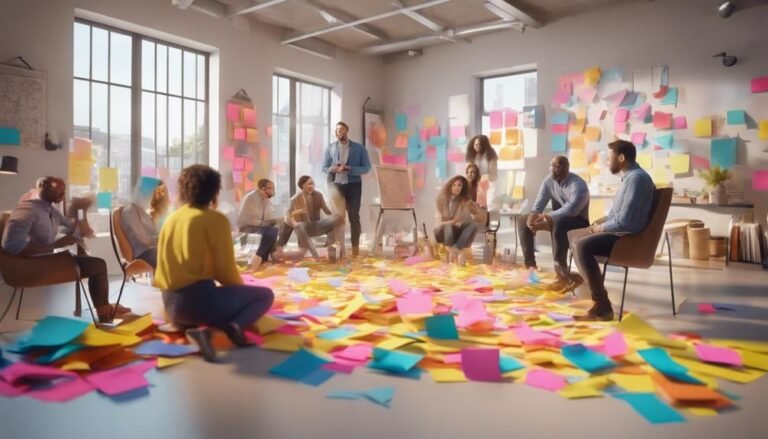Collaborative Learning as a Soft Skill
Collaborative learning as a soft skill equips you to excel in team environments by harnessing shared knowledge and diverse perspectives. Benefit from enhanced effectiveness and communication skills by embracing collaboration. Discover how teamwork in workplaces boosts productivity and fosters innovation. Tap into the power of diverse viewpoints for success. Embrace tools like virtual platforms for real-time interaction. Leaders play an essential role in fostering teamwork. Measure success through outcome evaluation and continuous learning. Embrace a growth mindset for collaboration improvement. Explore the depths of collaborative learning's significance and impact. Uncover the secrets to thriving in team dynamics!
Key Takeaways
- Collaboration cultivates communication and teamwork.
- Soft skills like active listening are essential.
- Peer feedback enhances personal and team growth.
- Collaborative learning fosters creativity and innovation.
- Group dynamics influence collaborative success.
The Significance of Collaborative Learning
Collaborative learning plays a vital role in fostering a dynamic and engaging educational environment where individuals actively participate and learn from one another. Group dynamics are at play when individuals come together, each bringing their unique perspectives and experiences to the table. Through this interaction, peer feedback becomes a valuable tool for personal and collective growth. By engaging in social learning, knowledge sharing becomes a two-way street where both giving and receiving knowledge are equally important.
In this environment, the exchange of ideas fuels creativity and innovation. Different viewpoints challenge assumptions, leading to deeper understanding and critical thinking. Working collaboratively also enhances communication skills as individuals learn to articulate their thoughts effectively to a diverse audience. Furthermore, the sense of shared responsibility within a group fosters accountability and teamwork. As each member contributes their expertise, a collective intelligence emerges, creating a rich learning experience for all involved.
Benefits of Collaboration in Workplaces
Let's talk about the perks of collaborating in the workplace.
Teamwork not only amps up productivity but also sharpens your problem-solving skills.
Additionally, it creates a breeding ground for innovation and sparks creativity among team members.
Teamwork Boosts Productivity
Teamwork greatly enhances productivity in the workplace, fostering a collaborative environment that fuels innovation and efficiency. When team dynamics are strong, employees are more engaged, communication flows better, and tasks are completed more effectively. Check out the table below to see some of the key productivity benefits that teamwork can bring to your workplace:
| Productivity Benefits of Teamwork | |
|---|---|
| 1. Enhanced Efficiency | Teams can divide tasks, leverage individual strengths, and work together to achieve goals faster. |
| 2. Increased Creativity | Collaborating allows for the sharing of diverse ideas, leading to more innovative solutions. |
| 3. Improved Problem-Solving | Different perspectives help in tackling challenges more effectively. |
| 4. Higher Employee Satisfaction | Working together fosters a sense of belonging and accomplishment. |
Enhances Problem-Solving Skills
Enhancing problem-solving skills through collaboration in the workplace is a pivotal aspect that leads to innovative solutions and effective decision-making. When you engage in collaborative problem-solving, you not only benefit from diverse perspectives but also sharpen your critical thinking abilities and enhance your creative problem-solving skills.
Here's how collaboration can enhance your problem-solving skills:
- Diverse Insights: Working with others exposes you to a variety of viewpoints, expanding your critical thinking capabilities.
- Brainstorming Sessions: Collaborative environments foster creative problem-solving by encouraging idea generation and out-of-the-box thinking.
- Constructive Feedback: Receiving input from team members helps refine your problem-solving approach and leads to more effective solutions.
- Shared Knowledge: Pooling expertise and experiences enables thorough problem analysis and innovative problem-solving strategies.
Fosters Innovation and Creativity
Promoting collaboration in the workplace cultivates a dynamic environment that sparks innovation and nurtures creativity among team members. Creative synergy flourishes as diverse perspectives merge, generating a melting pot of ideas that can revolutionize traditional approaches.
When individuals engage in innovative teamwork, they bounce ideas off each other, building upon initial concepts to create groundbreaking solutions. Collaboration fosters an atmosphere where risk-taking is encouraged, allowing for out-of-the-box thinking that leads to inventive outcomes.
Enhancing Team Performance Through Collaboration
When it comes to enhancing team performance through collaboration, remember that team synergy can greatly boost productivity levels.
Keep in mind that effective communication is key for the success of any collaborative effort.
Foster strong bonds within your team by building trust among members to guarantee a cohesive and high-performing unit.
Team Synergy Boosts Productivity
Team synergy, the harmonious collaboration of individuals towards a common goal, greatly boosts productivity in the workplace. When teams effectively leverage synergy, they can achieve remarkable results.
Here's how team synergy enhances productivity:
- Leveraging Team Dynamics: Embrace the unique strengths of team members to create a cohesive unit.
- Optimizing Individual Contributions: Encourage every team member to actively participate and share their expertise.
- Fostering Group Synergy: Cultivate a supportive environment where team members work together seamlessly.
- Streamlining Task Delegation: Assign roles based on individual strengths to maximize efficiency and outcomes.
Communication Key for Success
Enhancing team performance through collaboration hinges on effective communication as the keystone of success. Active listening plays an essential role in ensuring that team members understand each other's perspectives and ideas. By actively engaging in conversations, asking clarifying questions, and showing genuine interest, team members can foster a culture of open communication.
Conflict resolution is another crucial aspect of communication within a team. Addressing conflicts promptly and constructively can prevent misunderstandings from escalating and help maintain a positive team dynamic. Encouraging open dialogue and providing a safe space for team members to express their concerns can lead to smoother collaboration and improved overall team performance.
Trust Fosters Strong Bonds
Building strong bonds among team members is essential for enhancing collaboration and performance. When trust is established within a team, it fosters an environment where individuals can work together effectively towards a common goal.
Here are four ways trust enhances team performance through collaboration:
- Building relationships: Trust allows team members to develop genuine connections with one another, leading to better communication and understanding.
- Strengthening connections: Trust strengthens the bonds between team members, creating a sense of unity and increasing overall team cohesion.
- Promoting transparency: Trust encourages openness and honesty within the team, fostering a culture where feedback can be given and received constructively.
- Boosting productivity: When trust is present, team members feel more comfortable taking risks, leading to increased innovation and productivity.
Building Trust and Communication Skills
To foster effective collaboration, start by nurturing a foundation of trust and honing your communication skills. Trust building is essential for successful teamwork, as it establishes a secure space for sharing ideas and feedback. Effective communication guarantees that everyone is on the same page, reducing misunderstandings and enhancing productivity. Here are some practical tips to help you build trust and improve your communication skills:
| Trust Building | Effective Communication | Practice Active Listening |
|---|---|---|
| Be reliable and honest | Clearly articulate ideas | Engage fully in conversations |
| Show empathy and support | Encourage open dialogue | Ask clarifying questions |
| Respect boundaries | Provide constructive feedback | Reflect on what others say |
Leveraging Diversity for Collaborative Success
As you navigate the world of collaborative learning, harnessing the power of diverse perspectives is key to achieving success together. Leveraging diversity for collaborative success involves understanding how different backgrounds, experiences, and viewpoints can come together to create something greater than the sum of its parts. Here are some tips to help you make the most of diversity synergy:
- Embrace Differences: Celebrate the unique qualities that each team member brings to the table. Recognize that diversity is a strength that can lead to innovative solutions.
- Active Listening: Take the time to truly listen and understand other perspectives. Acknowledging and valuing diverse opinions can lead to more effective collaboration.
- Cultural Awareness: Be mindful of cultural nuances and differences. Respect for diverse traditions and practices fosters an inclusive environment where everyone feels valued.
- Open Communication: Encourage open and transparent communication within your team. Creating a safe space for dialogue allows for constructive discussions that propel collaborative success.
Overcoming Challenges in Collaborative Environments
Operating in cooperative environments can present various hurdles that require proactive strategies and effective communication to overcome. Conflict resolution strategies play a vital role in maneuvering these challenges. When conflicts arise, it's essential to address them promptly and constructively. Encouraging open communication, active listening, and empathy can help in resolving differences and fostering a positive environment for collaboration.
Understanding group dynamics is another key aspect of overcoming challenges in cooperative environments. Each team member brings unique strengths and perspectives to the table, which can sometimes lead to friction. By acknowledging and valuing these differences, you can build rapport and foster teamwork effectively. Creating opportunities for team members to bond outside of work tasks can also strengthen relationships and enhance collaboration.
Tools and Technologies for Collaborative Learning
When exploring collaborative learning, embracing a variety of tools and technologies can greatly enhance the overall experience and outcomes for participants. Here are some key tools and technologies that can facilitate collaborative learning:
- Virtual collaboration platforms: Utilize platforms like Microsoft Teams, Google Workspace, or Slack to allow real-time communication, file sharing, and project collaboration.
- Interactive tools: Incorporate interactive whiteboards, polling tools, and collaborative document editing features to engage participants and promote active participation.
- Online learning communities: Join online forums, social media groups, or educational platforms to connect with like-minded individuals, share resources, and engage in discussions.
- Digital resources: Access online libraries, educational websites, and multimedia content to provide diverse learning materials and enhance the collaborative learning experience.
Role of Leadership in Fostering Collaboration
To propel collaborative learning to its fullest potential, leaders play a pivotal role in fostering a culture of teamwork and synergy within a group. The leadership role in fostering collaboration is vital for creating an environment where team members feel valued, encouraged to share ideas, and motivated to work towards common goals. Effective leaders set the tone for a collaborative culture by promoting open communication, trust, and respect among team members.
Leaders who prioritize collaboration demonstrate the importance of working together towards a shared vision. They encourage participation from all team members, ensuring that diverse perspectives are heard and valued. By fostering a collaborative culture, leaders empower individuals to contribute their unique skills and knowledge, leading to innovative solutions and increased productivity.
Moreover, leaders play a key role in resolving conflicts that may arise during collaborative projects. By promoting a culture of open dialogue and constructive feedback, leaders can help teams navigate challenges effectively and maintain a positive working environment. Overall, the leadership role in fostering collaboration is essential for driving success in collaborative learning initiatives.
Measuring Success in Collaborative Projects
When measuring success in collaborative projects, you'll focus on evaluating the project outcomes, appraising each team member's contribution, and determining the overall impact of collaboration. These points serve as vital indicators of the effectiveness and efficiency of the collaborative efforts put forth.
Project Outcome Assessment
Evaluating project outcomes in collaborative endeavors is essential for gauging success and enhancing future team performance. When appraising project outcomes, consider the following:
- Project Evaluation: Reflect on the project goals, deliverables, and timelines. Evaluate if the objectives were met and identify areas for improvement.
- Group Dynamics: Analyze how well the team worked together. Consider communication, conflict resolution, and overall cohesion within the group.
- Team Assessment: Reflect on individual contributions and how they impacted the overall project. Recognize strengths and areas for development within the team.
- Collaborative Approach: Assess the effectiveness of the collaborative process. Evaluate how well team members shared responsibilities, leveraged diverse skills, and supported one another throughout the project.
Team Contribution Evaluation
Evaluating individual team contributions is essential for determining the success of collaborative projects and enhancing future teamwork dynamics. Performance evaluation allows for recognizing each team member's strengths and areas for improvement.
By appraising contributions, it becomes easier to identify who excels in specific tasks, ensuring tasks align with individual skills for best team performance. Constructive feedback from these evaluations fosters growth within the team, improving overall team dynamics.
Understanding how each member contributes helps in redistributing tasks effectively, balancing workload, and maximizing efficiency. Additionally, acknowledging and rewarding outstanding performances can motivate team members, leading to increased engagement and collaboration.
Regular performance evaluations not only measure success but also create a culture of continuous improvement within the team, promoting stronger team dynamics.
Impact of Collaboration
Wondering how to measure the success of collaborative projects effectively? When evaluating the impact of collaboration, consider the following key aspects:
- Group Dynamics: Assess how well the team worked together, resolved conflicts, and supported each other. Strong group dynamics often indicate successful collaboration.
- Peer Learning: Measure the extent to which team members learned from each other during the project. Peer learning is a valuable outcome of collaboration that contributes to overall success.
- Social Interaction: Evaluate the level of engagement and communication among team members. Effective social interaction fosters trust and enhances the collaborative process.
- Knowledge Sharing: Quantify the amount of information exchanged and utilized within the team. Successful collaboration often leads to rich knowledge sharing, benefiting all members involved.
Continuous Learning and Improvement in Collaboration
To enhance your collaborative skills, focus on continuously learning and improving your ability to work together effectively with others. Continuous improvement in collaboration involves cultivating a learning culture within your team or group. This means encouraging a mindset where every interaction is viewed as an opportunity to grow and enhance your collaborative skills.
One way to promote continuous learning in collaboration is by seeking feedback from your peers regularly. Constructive feedback can provide valuable insights into areas where you can improve and help you identify blind spots in your collaborative approach. Additionally, reflecting on past collaborations and identifying what worked well and what didn't can contribute to your growth in this area.
Moreover, embracing a growth mindset is essential for continuous improvement in collaboration. Understand that collaboration is a skill that can be developed and refined over time through practice and feedback. By maintaining a willingness to learn from every collaboration experience, you can steadily enhance your ability to work effectively with others.
Conclusion
As you journey through the landscape of collaborative learning, remember that teamwork is like a symphony, where each instrument plays an essential role in creating harmony. Just as musicians must listen to each other and work together to create beautiful music, so too must individuals in a collaborative setting communicate, trust, and leverage their unique strengths to achieve success.
Embrace the power of collaboration, for together you can achieve greatness beyond what any one person could accomplish alone.








